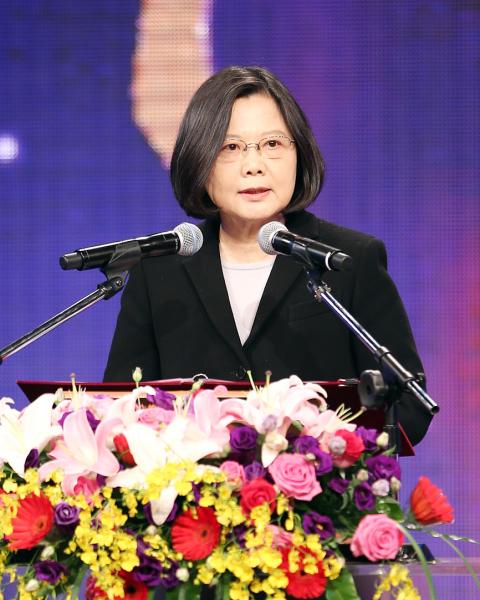The Presidential Office yesterday thanked the US government for deepening Taiwan-US relations, saying that it hopes to further improve ties with the administration of US president-elect Donald Trump.
The government thanked the administration of US President Barak Obama for its support over the past eight years, including selling arms to Taiwan, helping enhance Taiwan’s self-defense capabilities, upgrading bilateral trade and economic relations and helping Taiwan participate in international activities, Presidential Office spokesman Alex Huang (黃重諺) said in a statement.
“As a democracy, just like the United States, we also thank the US government for not treating its relationship with Taiwan as subordinate to or an extension of US relations with other nations and for strengthening Taiwan-US relations step by step,” Huang said. “Taiwan hopes to strengthen its relations with the incoming Trump administration on this robust foundation for bilateral relations.”

Photo: Chen Yi-kuan Taipei Times
The administration of President Tsai Ing-wen (蔡英文) is committed to maintaining the “status quo” of peace across the Taiwan Strait, the statement said.
“It is our government’s abiding position to maintain Taiwan’s freedom and democracy and to maintain peace in the Taiwan Strait and the ‘status quo’ of peace and stability in cross-strait relations,” Huang said.
Huang’s remarks followed comments by Obama on Taiwan and China on Friday at his year-end news conference, his last before departing the White House on Jan. 20.
It was the first time Obama spoke extensively about the Taiwan-US-China relationship since Trump made remarks questioning Washington’s “one China” policy, under which the US acknowledges, but does not necessarily accept, Beijing’s position that there is only “one China.”
Obama was answering a question on whether the US’ policy toward China could use a fresh approach, as suggested by Trump’s recent comments, in which he appeared to say that he would not necessarily be bound by the US’ “one China” policy, unless it received trade concessions from Beijing.
There has been a long-standing agreement between China, the US and, to some degree, Taiwanese, and that is to not change the “status quo,” Obama said.
“China views Taiwan as part of China, but recognizes that it has to approach Taiwan as an entity that has its own ways of doing things,” Obama said. “The Taiwanese have agreed that as long as they’re able to continue to function with some degree of autonomy, that they won’t charge forward and declare independence.”
“And that ‘status quo,’ although not completely satisfactory to any of the parties involved, has kept the peace and allowed the Taiwanese to be a pretty successful economy and a people who have a high degree of self-determination,” he said.
However, he warned against changing the “status quo.”
“But understand, for China, the issue of Taiwan is as important as anything on their docket. The idea of ‘one China’ is at the heart of their conception as a nation,” Obama said.

TRAGEDY STRIKES TAIPEI: The suspect died after falling off a building after he threw smoke grenades into Taipei Main Station and went on a killing spree in Zhongshan A 27-year-old suspect allegedly threw smoke grenades in Taipei Main Station and then proceeded to Zhongshan MRT Station in a random killing spree that resulted in the death of the suspect and two other civilians, and seven injured, including one in critical condition, as of press time last night. The suspect, identified as a man surnamed Chang Wen (張文), allegedly began the attack at Taipei Main Station, the Taipei Fire Department said, adding that it received a report at 5:24pm that smoke grenades had been thrown in the station. One man in his 50s was rushed to hospital after a cardiac arrest

SAFETY FIRST: Double the number of police were deployed at the Taipei Marathon, while other cities released plans to bolster public event safety Authorities across Taiwan have stepped up security measures ahead of Christmas and New Year events, following a knife and smoke bomb attack in Taipei on Friday that left four people dead and 11 injured. In a bid to prevent potential copycat incidents, police deployments have been expanded for large gatherings, transport hubs, and other crowded public spaces, according to official statements from police and city authorities. Taipei Mayor Chiang Wan-an (蔣萬安) said the city has “comprehensively raised security readiness” in crowded areas, increased police deployments with armed officers, and intensified patrols during weekends and nighttime hours. For large-scale events, security checkpoints and explosives

A car bomb killed a senior Russian general in southern Moscow yesterday morning, the latest high-profile army figure to be blown up in a blast that came just hours after Russian and Ukrainian delegates held separate talks in Miami on a plan to end the war. Kyiv has not commented on the incident, but Russian investigators said they were probing whether the blast was “linked” to “Ukrainian special forces.” The attack was similar to other assassinations of generals and pro-war figures that have either been claimed, or are widely believed to have been orchestrated, by Ukraine. Russian Lieutenant General Fanil Sarvarov, 56, head

PUBLIC SAFETY: The premier said that security would be tightened in transport hubs, while President Lai commended the public for their bravery The government is to deploy more police, including rapid response units, in crowded public areas to ensure a swift response to any threats, President William Lai (賴清德) said yesterday after a knife attack killed three people and injured 11 in Taipei the previous day. Lai made the remarks following a briefing by the National Police Agency on the progress of the investigation, saying that the attack underscored the importance of cooperation in public security between the central and local governments. The attack unfolded in the early evening on Friday around Taipei Main Station’s M7 exit and later near the Taipei MRT’s Zhongshan